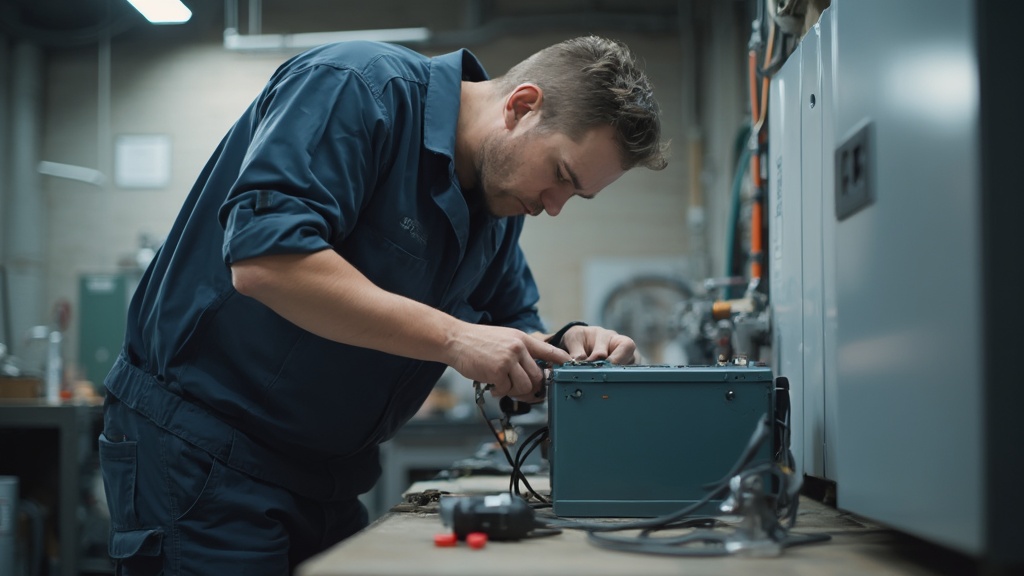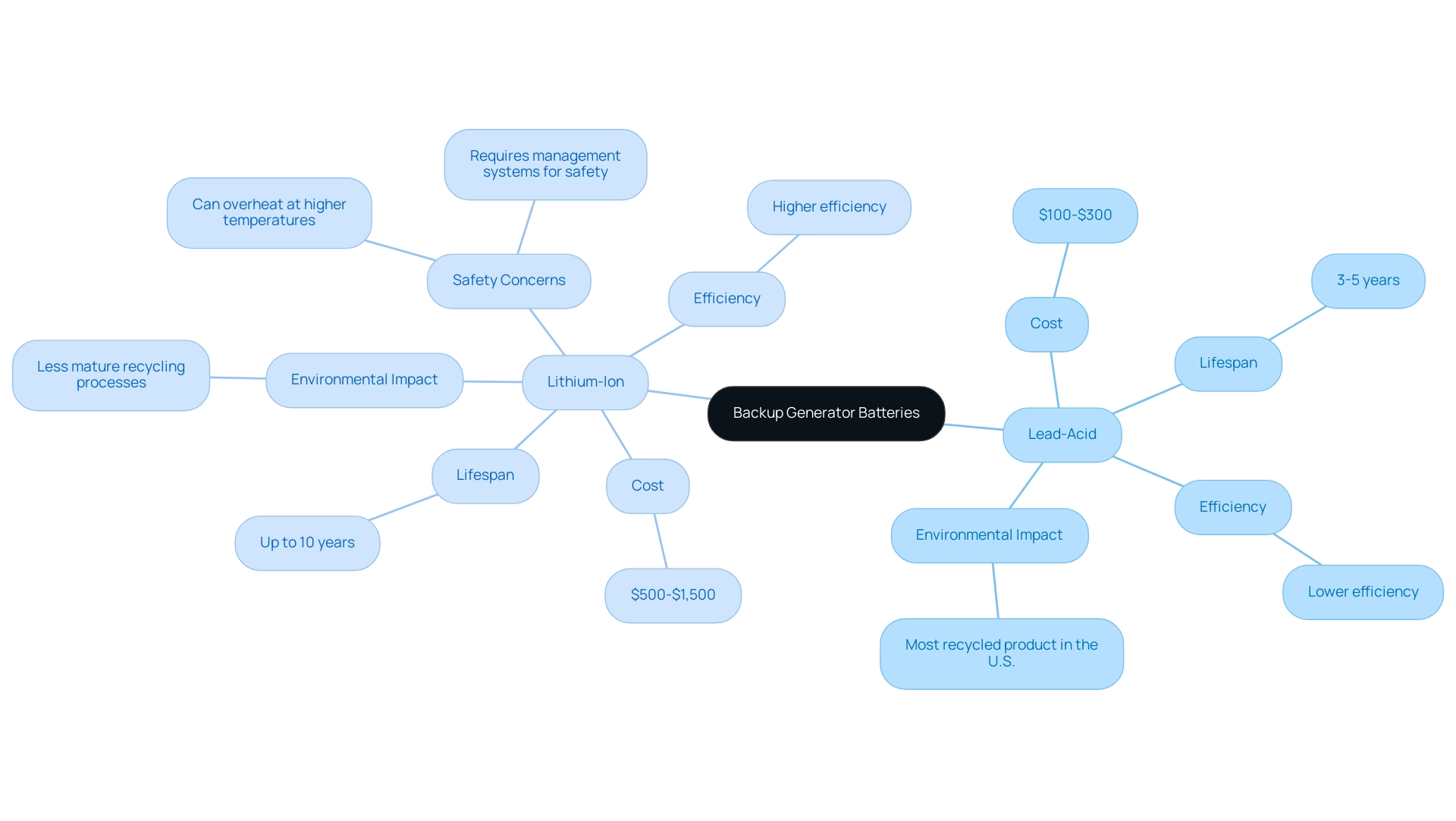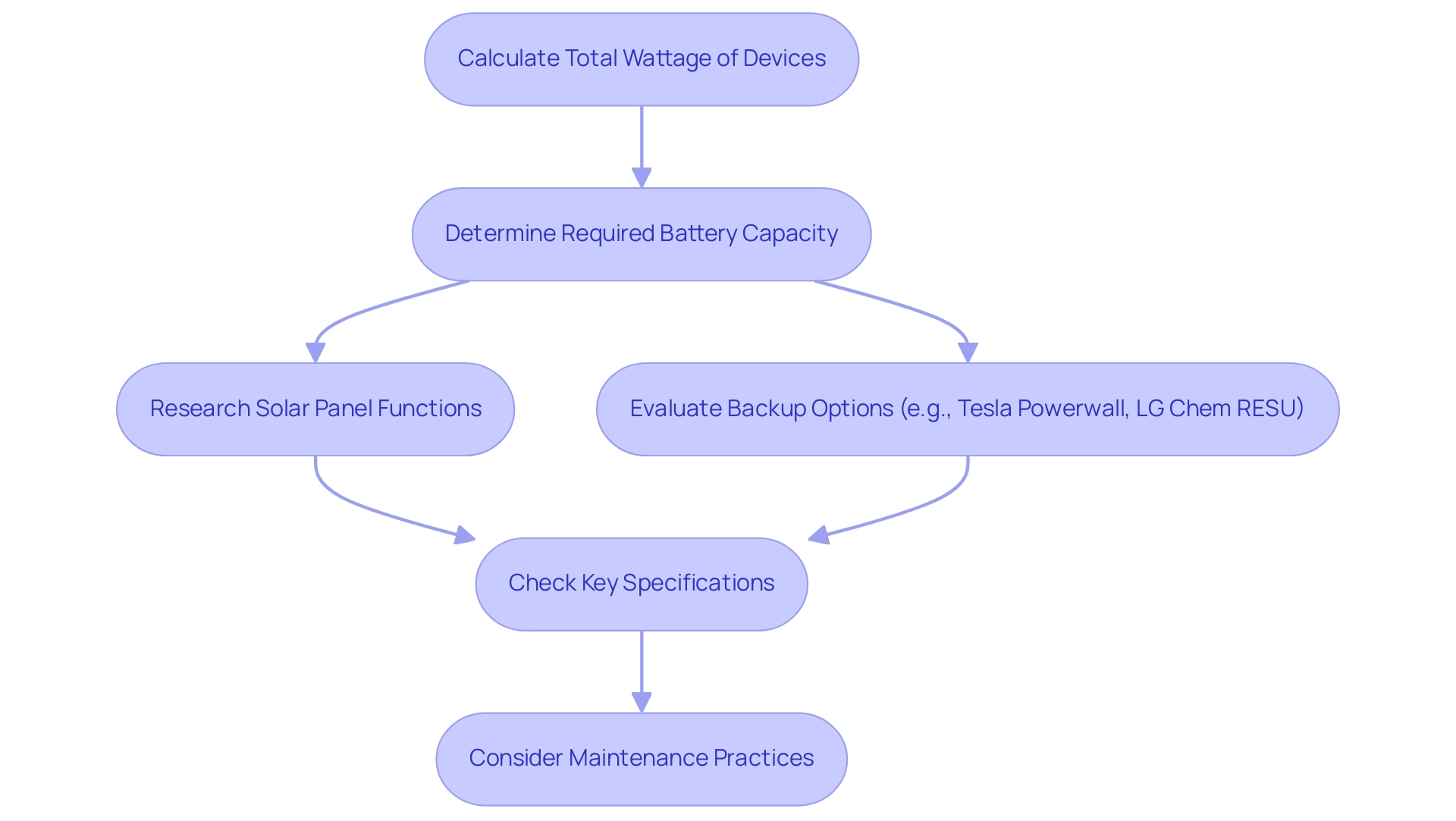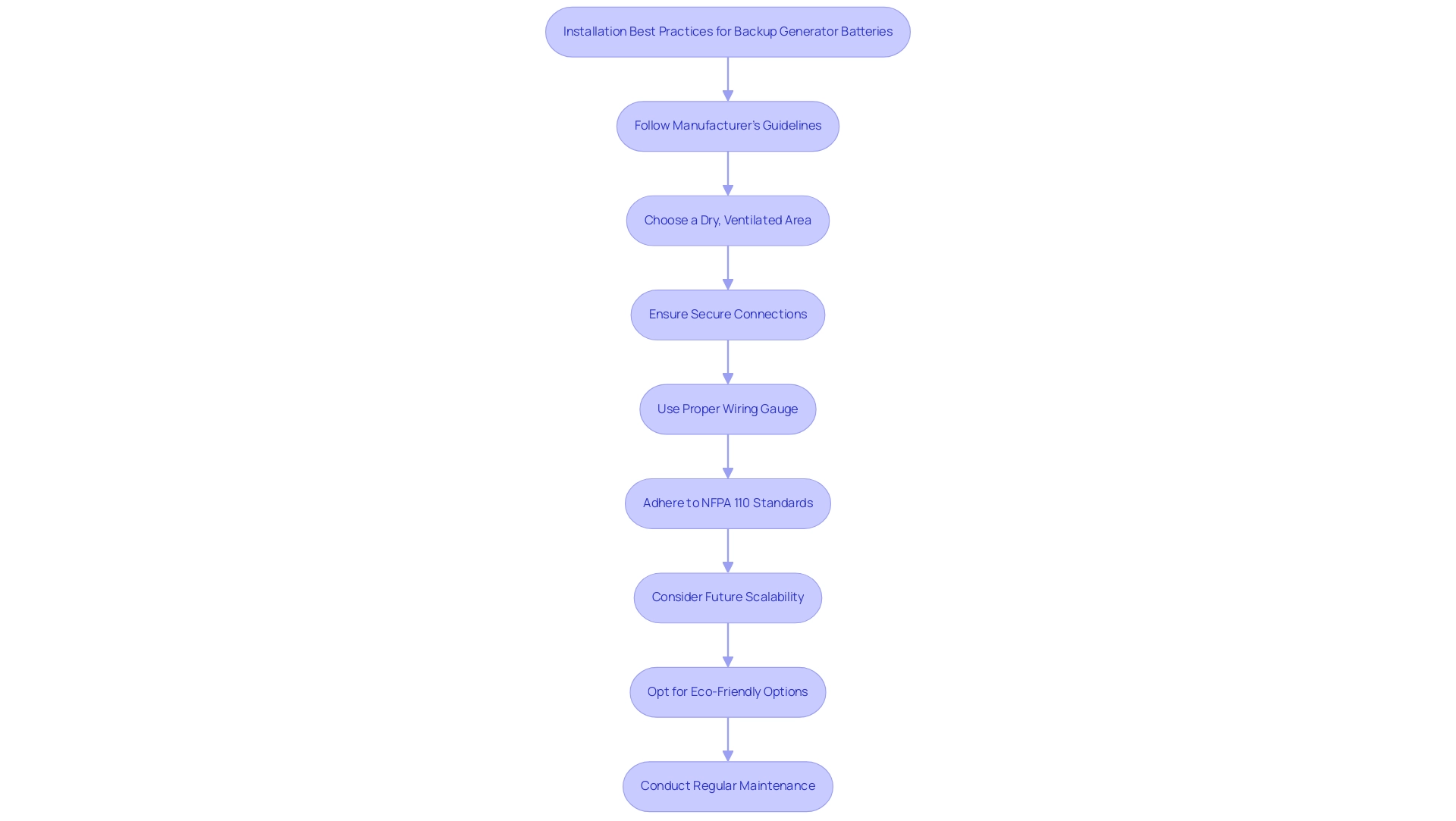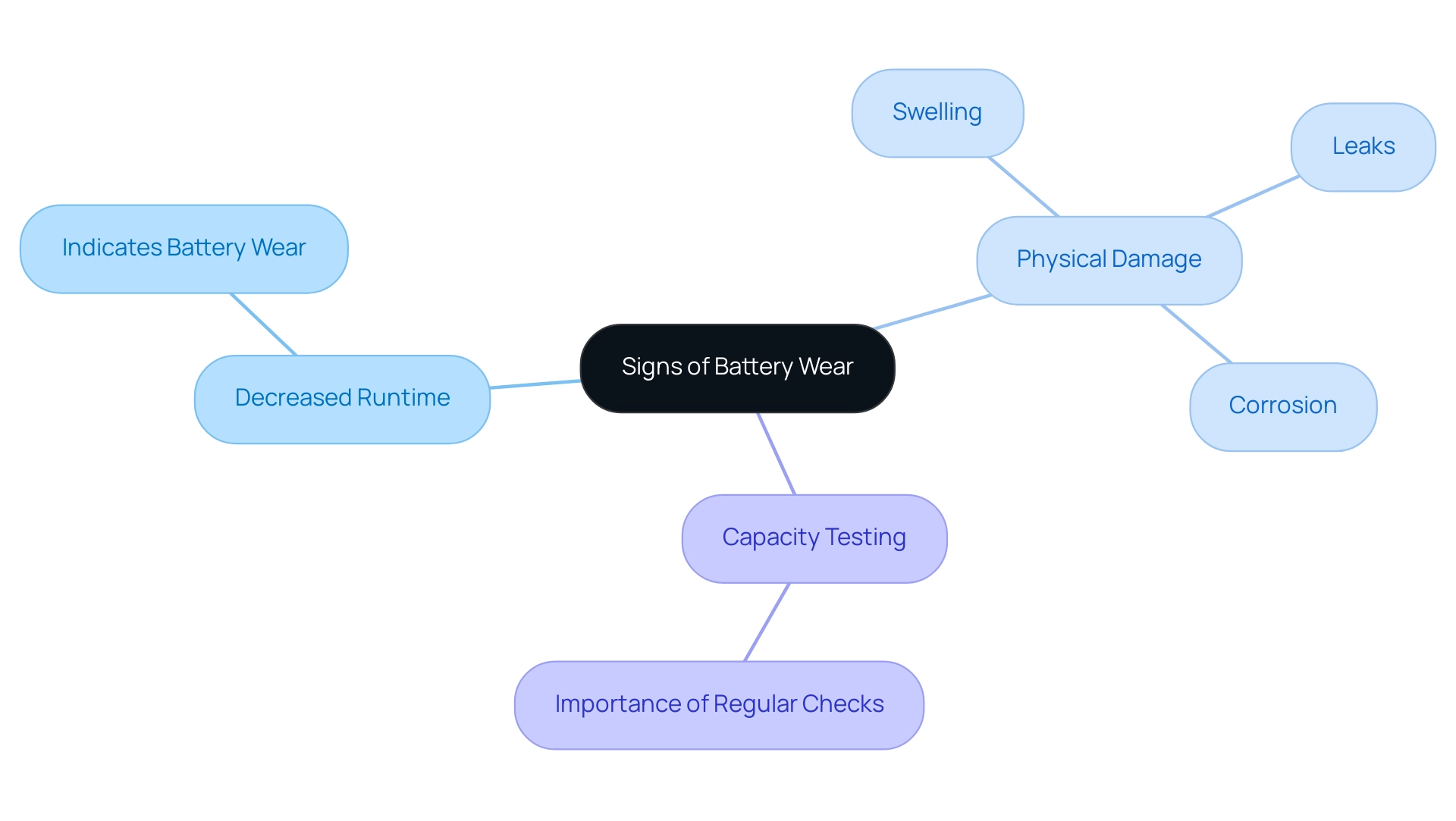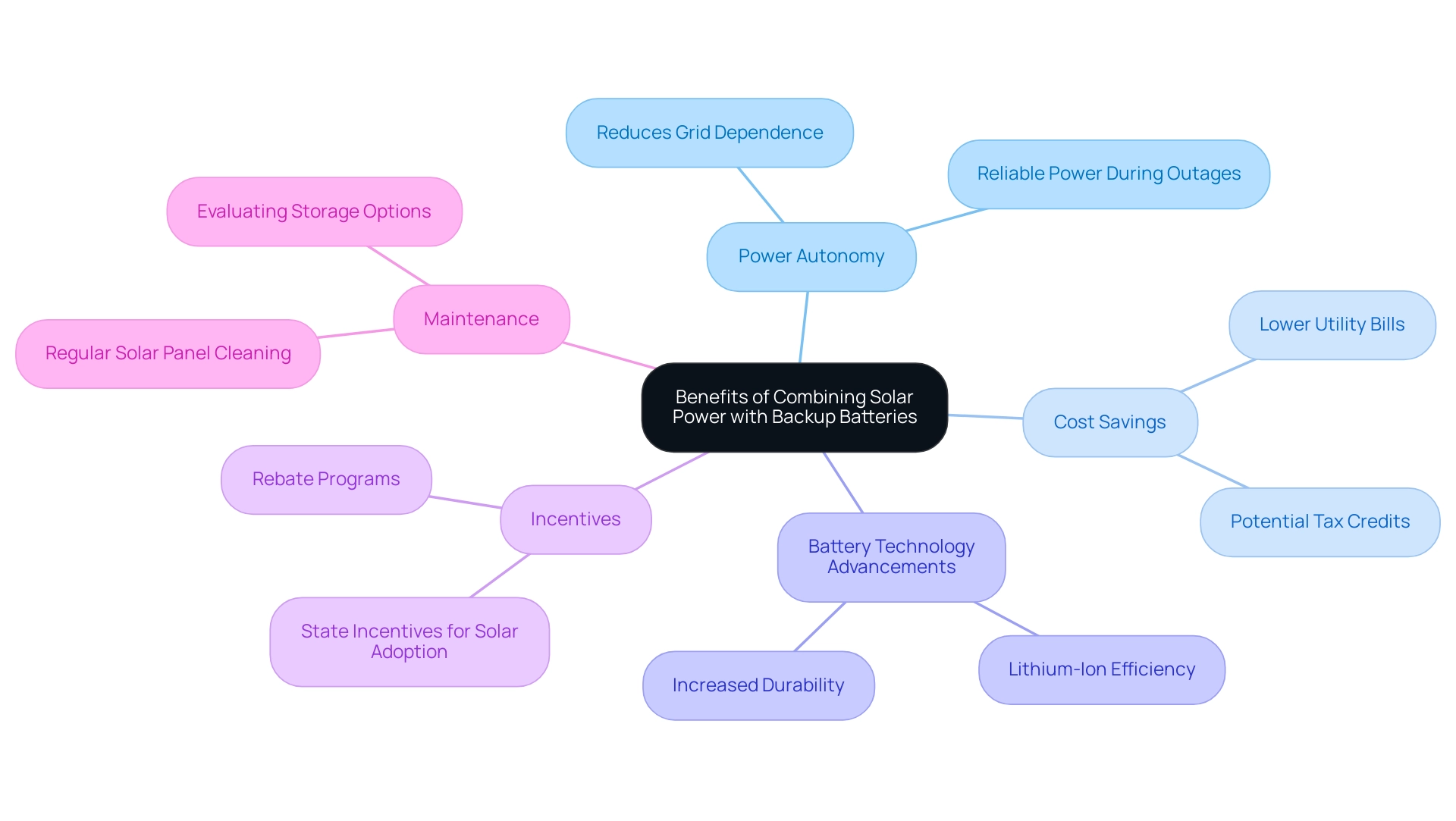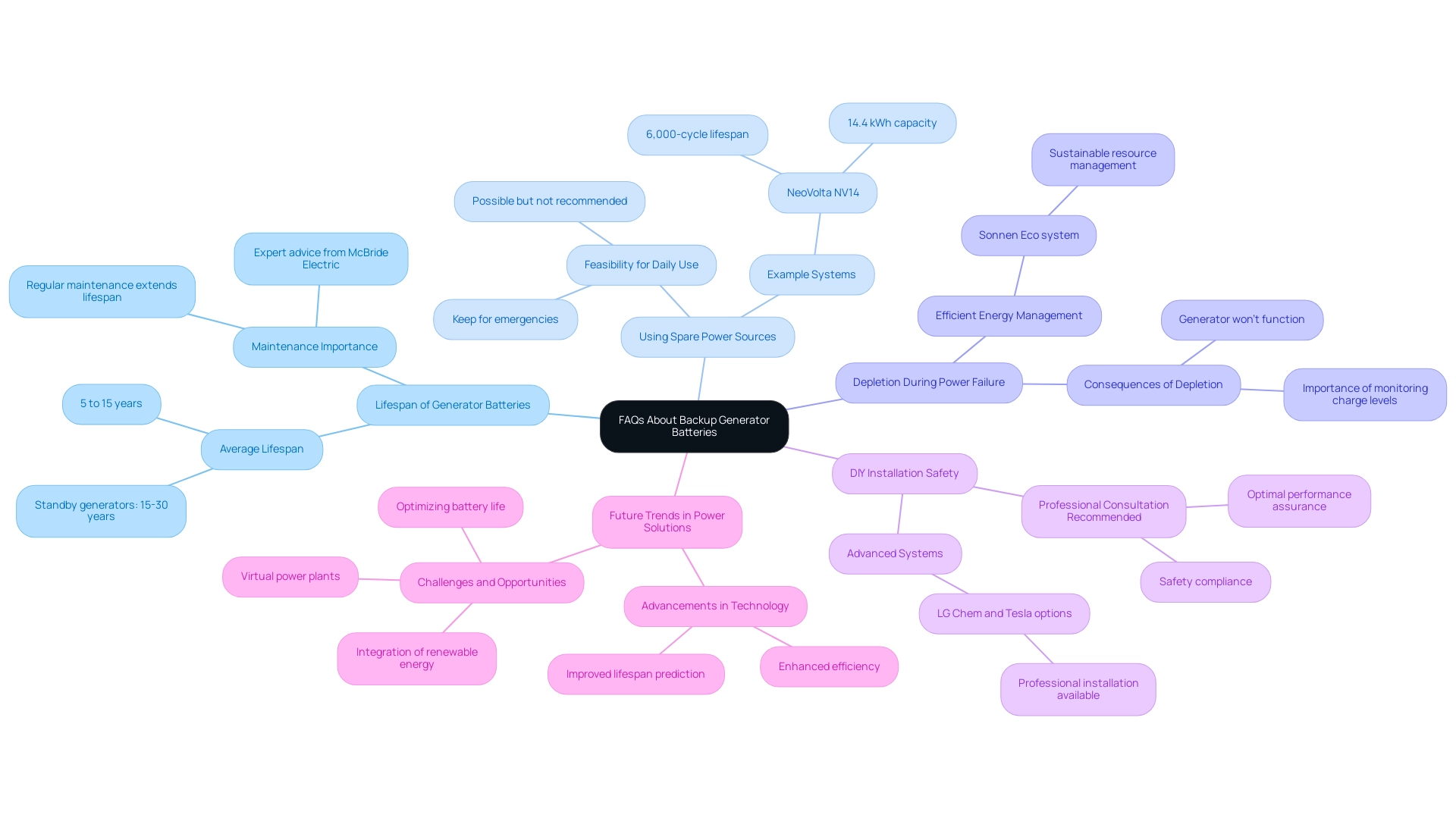Introduction
In the quest for reliable home energy solutions, backup generator batteries play a pivotal role in ensuring peace of mind during unexpected outages. As homeowners navigate the choices between lead-acid and lithium-ion batteries, understanding their distinct features and benefits becomes essential.
From evaluating energy consumption needs to mastering installation best practices, this guide offers a comprehensive look at everything one needs to know about backup battery systems. With insights into:
- Maintenance
- Signs of wear
- The advantages of integrating solar power
Readers will find practical advice to help them make informed decisions that enhance their energy independence and sustainability. Embracing these strategies not only prepares homes for power interruptions but also contributes to a greener future.
Understanding the Basics of Backup Generator Batteries
When it comes to backup generator battery power sources, homeowners typically choose between two main types: lead-acid and lithium-ion. Lead-acid cells have been around for a while and often come with a lower upfront cost, usually ranging from $100 to $300, making them an attractive option. In fact, the Environmental Protection Agency ranks lead cells as the most recycled product in the U.S., which speaks to their sustainability.
However, they usually have shorter lifespans (3-5 years) and are less efficient compared to their lithium-ion counterparts. On the flip side, lithium-ion cells might hit your wallet a bit harder initially, with prices between $500 and $1,500, but they shine with longer lifespans (up to 10 years), greater efficiency, and quicker charging times. For instance, Eco Tree Lithium cells provide a written warranty of 6 years, emphasizing their durability.
An essential aspect to contemplate is the depth of discharge (DoD), which indicates how much power you can safely extract from the unit before it requires recharging. Additionally, top-performing options like the Tesla Powerwall and LG Chem RESU offer innovative features and reliable performance, catering to various power requirements. It’s crucial to recognize that although lithium-ion cells have higher initial expenses and necessitate management frameworks for safety, their advantages in terms of longevity and efficiency render them a compelling option.
Moreover, investing in storage systems contributes to reducing dependence on fossil fuels and lowering carbon emissions, supporting a cleaner and more sustainable future. By understanding these essentials, you can make a well-informed decision about which type of power source will best meet your needs and lifestyle.
Key Considerations for Sizing and Maintaining Your Backup Battery
When selecting a backup power source for your home, the first step is to understand your household’s energy consumption during outages. Take a moment to calculate the total wattage of the devices you plan to power—this might include essentials like your refrigerator, lights, and any medical equipment. For instance, if your total wattage is 1,500 watts and you want to run these devices for 4 hours, you’ll need a power source that can handle at least 6,000 watt-hours.
This comprehension not only assists in selecting the appropriate size but also corresponds with the best options available in the market today.
To understand how solar panels function with energy storage units, it’s crucial to recognize that solar panels transform sunlight into electricity, which can be retained in accumulators for future use, particularly during outages. The significance of dependable support systems cannot be overstated, especially considering that 343,000 households reported water collected in their basement or crawl space due to sump pump failure. A reliable backup generator battery can prevent such issues, safeguarding your home from damage during outages.
Popular choices like the Tesla Powerwall and LG Chem RESU, recognized for their efficiency and strong performance, further enable homeowners in attaining independence in power supply.
When assessing these selections, consider key specifications such as:
- Storage capacity
- Cycle life
- Warranty durations, usually lasting a minimum of ten years
The economic advantages of investing in a quality solar storage system are significant; they can reduce reliance on grid power and lower energy bills over time. Maintenance plays a crucial role in ensuring that your backup generator battery remains reliable.
Regularly checking the charge level of your backup generator battery is a good habit, as it helps you gauge its readiness for an emergency. Conducting regular tests will also verify that your setup is operating correctly. Maintaining cleanliness and ensuring adequate ventilation are crucial practices that enhance its lifespan—dust and heat can adversely affect performance.
By considering the features of leading products like the Sonnen Eco and NeoVolta’s NV14 while following these maintenance guidelines, you’ll improve the reliability of your reserve power source. This proactive approach is essential for maintaining property value and safety, as highlighted in recent housing data discussions. Additionally, adopting efficient practices can reduce costs and improve overall efficiency during peak usage times, giving you peace of mind as a homeowner.
Furthermore, exploring broader impacts such as virtual power plant business models can further enhance the economic benefits of your solar investment, showcasing how combined groups of home energy storage systems can improve grid stability and efficiency.
Installation Best Practices for Backup Generator Batteries
When it comes to installing a backup generator, following the manufacturer’s guidelines is crucial for both safety and efficiency. Choose a dry and well-ventilated area to prevent overheating; this is especially important since placing the device in direct sunlight or near heat sources can lead to premature failure. Ensure all connections are secure, and use the proper wiring gauge to manage the load effectively.
It’s essential to be aware of NFPA 110 standards, which outline the operational and testing requirements that ensure safety and compliance, particularly for commercial applications. A professional installer can provide invaluable assistance, ensuring that your setup adheres to local regulations and safety standards. As mentioned by a specialist in the field, ‘I simply want to ensure I can scale the energy storage in the future,’ emphasizing the significance of not only immediate installation but also preparation for future requirements.
For eco-conscious homeowners, considering a backup generator battery that stores solar electricity can enhance your energy independence and provide peace of mind against blackouts. Regular maintenance is key; homeowners should conduct monthly visual inspections and annual tests, checking for any signs of wear or malfunction. This practice not only guarantees the longevity and performance of the power source but also acts as a standard for upholding safety and efficiency.
Remember, a proper installation enhances performance and significantly extends the lifespan of your power system, making it a smart investment for your home.
Recognizing Signs of Battery Wear and When to Replace
Keep an eye out for key indicators that your backup generator battery might be reaching the end of its life. Signs such as:
- A noticeable decrease in runtime during power outages
- Any swelling or leaks
- Corrosion on the terminals
can all signal potential issues. If you notice any of these warning signs, it’s essential to test the power source’s capacity.
Andrew F. Burke, a Ph.D. in Aerospace Engineering, emphasizes, “Monitoring power cell performance is crucial, as consistent wear can lead to diminished capacity over time.” Remember, most lithium-ion cells typically degrade to about 80% of their full capacity after 500 to 2,000 cycles. Regularly checking your system every few months can help you catch these problems early, ensuring that your generator is always prepared to step in when you need it the most.
For instance, Simon’s experience with a 36V – 14 amp Li+Polymer power source for his electric bicycle, which lasted only 13 months and 1400 miles, illustrates the importance of monitoring longevity. By being proactive about maintenance, you can maintain your peace of mind during unexpected power outages.
The Benefits of Combining Solar Power with Backup Batteries
Combining solar panels with a backup generator battery creates a powerful solution for sustainable power while enhancing your home’s power autonomy. On bright days, your solar panels efficiently charge the backup generator battery, ensuring you have a supply of power ready for those unforeseen outages. Recent advancements in battery technology, particularly lithium-ion batteries, have significantly improved their durability and efficiency, making them an even more reliable option for homeowners.
As experts note, ‘Battery technology advancements have increased durability and efficiency over the years, and this will continue.’ This arrangement not only reduces your dependence on the grid but can also result in significant savings on your utility bills by utilizing a backup generator battery. Many states are incentivizing the adoption of solar technologies, including potential tax credits and rebate programs, which makes this investment particularly appealing.
A case study titled ‘Does Home Solar Battery Make Sense For You in 2023?’ emphasizes investing in solar power storage, highlighting how it can assist homeowners in lowering utility costs and gaining control over consumption, making it a valuable consideration, particularly during emergencies when a backup generator battery can provide additional support. By investing in solar and battery solutions, you’re not just enhancing your comfort and sustainability; you’re also contributing to a cleaner environment and potentially reaping significant financial benefits.
Additionally, exploring options like Tesla home chargers can further complement your solar setup, providing you with efficient power solutions tailored to your eco-conscious lifestyle. It’s also important to consider regular maintenance, including solar panel cleaning services, to ensure optimal performance of your solar energy system. Furthermore, evaluating leading solar storage options in the market can guide homeowners in making informed choices based on features, market trends, and consumer considerations.
Frequently Asked Questions About Backup Generator Batteries
-
How long do power generator cells endure?
On average, generator power sources can endure anywhere from 5 to 15 years, depending largely on the kind of unit and how well it’s maintained. Standby generators can run for 10,000 to 30,000 hours, translating to an impressive lifespan of 15-30 years for residential use. Regular maintenance plays a crucial role in extending the lifespan of your backup generator battery, just like McBride Electric suggests. By following maintenance guidelines, you can ensure that your power source remains in optimal condition for as long as possible. Notably, brands like the Tesla Powerwall, which features robust software integration and monitoring capabilities, and LG Chem RESU, known for its excellent performance and compatibility with various inverters, are designed with longevity in mind, often featuring warranties that last at least ten years.
-
Can I utilize my spare power source for standard energy requirements?
Yes, it’s technically feasible to utilize your spare power source for daily energy requirements, but it’s prudent to keep it mainly for emergencies. This approach ensures that it retains enough capacity to activate when you really need it. Consider your reserve power source as your safety net—keeping it prepared for those unforeseen outages is essential! Innovations like the NeoVolta NV14 system, which features a solar-rechargeable 14.4 kWh power system and an impressive 6,000-cycle lifespan, also offer flexibility in energy usage, making it a dependable choice for both emergency and daily needs.
What occurs if my spare power source depletes during a power failure?
If your backup power source runs out, your generator won’t have the power it needs to function. That’s why it’s important to keep a close eye on the charge levels of your backup generator battery. Consistently checking and replenishing the backup generator battery can help you prevent any unexpected issues during an outage. Utilizing power sources like the Sonnen Eco, which emphasizes sustainable resource management, can help ensure efficient energy management, prolonging usage during critical times.
Is it safe to install a spare battery myself?
While many homeowners are handy enough to tackle a DIY installation, it’s generally safer to consult a professional, especially for larger systems. A professional can help ensure that everything is installed correctly and complies with safety regulations, giving you peace of mind as you establish your power solution. Many of the advanced solar power systems, such as those from LG Chem or Tesla, come with professional installation options to ensure optimal performance.
What are the future trends in backup power solutions?
As energy storage technology advances, we can expect improvements in lifespan prediction and efficiency. Key challenges remain, such as optimizing battery life and integrating renewable energy sources. However, opportunities for innovation are vast, with trends like the incorporation of virtual power plants enhancing the value of home storage systems. These models can increase grid stability and efficiency, aligning perfectly with eco-conscious solutions that promote sustainable living.
Conclusion
Understanding the different types of backup generator batteries, such as lead-acid and lithium-ion, is crucial for homeowners looking to enhance their energy independence. Each type has its unique advantages and considerations, from cost and lifespan to efficiency and environmental impact. By carefully evaluating energy consumption needs and choosing the right battery, homeowners can ensure they are well-prepared for unexpected outages while also contributing to a more sustainable future.
Proper sizing, installation, and maintenance of backup batteries are essential steps that cannot be overlooked. Homeowners should assess their energy requirements, follow best practices during installation, and remain vigilant for signs of wear and tear. Regular checks and maintenance not only prolong the battery’s lifespan but also guarantee that the system operates at peak efficiency when it is needed most.
Moreover, the integration of solar power with battery systems presents an exciting opportunity to further reduce reliance on the grid and save on energy costs. As technology advances, homeowners can benefit from innovative solutions that enhance both energy independence and environmental sustainability. By investing in these systems, individuals are not just preparing for power interruptions; they are taking meaningful steps toward a greener lifestyle.
In summary, the journey to reliable home energy solutions through backup generator batteries is filled with choices and considerations. With the right knowledge and proactive approach, homeowners can confidently navigate this landscape, ensuring their homes remain powered and their contributions to a sustainable future are solidified.


